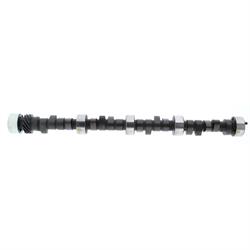Pick The Right Camshaft For Your Project
From mild to wild, Speedway Motors offers close to 100 various grinds of camshafts for your selection. From a cam for your 1932-1948 Flathead, to a small block Chevy, all the way up to a 460 Ford and a 496 Chevy BB, we have it.
There are a lot of things to consider when choosing a cam for your engine. The lift, duration, and separation are just a few. Primarily, you have to ask yourself what you intend on doing with the car. Do you want a strip-ready 10 second car, or do you want to be able to drive it on nice days?
What we did was come up with 4 different sample vehicles, and asked our in-house techs what cam they would recommend for each vehicle. We’ll call these cars primarily street, with the occasional drag strip weekend.
The "Real World" Examples:
- 350 S/B Chevy - 9.0:1 compression, dual plane intake, 600cfm carb, auto transmission 3400 pound weight 260°-268° advertised duration, 210°-220° duration at 0.050" lift
- 302 Ford- 8.5:1 compression, dual plane intake, 550cfm carb, 4 speed transmission, 3400 pound weight 260°-268° advertised duration, 210°-220° duration at 0.050" lift
- 454 B/B Chevy- 9.0:1 compression, dual plane intake, 750cfm carb, auto transmission, 3400 pound weight 270°-292° advertised duration, 224°-244° duration at 0.050" lift (NOTE: the 280° will need a 2500 RPM stall converter, the 292° will require a 3000 RPM minimum)
- 383 S/B Chevy- 10:1 compression, dual plane intake, 750cfm carb, 5 speed transmission, 3400 pound weight 280°-292° advertised duration, 230°-244° duration at 0.050" lift (NOTE: the 280° will need a 2500 RPM stall converter, the 292° will require a 3000 RPM minimum)
Whatever choice you settle on, it is recommended that you upgrade to stiffer valve springs as well, otherwise you may pick up a little “valve float” at high RPM’s. You’ll know that when it happens, because you will lose power all of a sudden. Your valve springs should always be matched to the recommended seat pressure set forth by the cam manufacturer. Too little seat pressure causes valve float can bend valves and cause damage to pistons and cylinder heads when valves hang open too long. Too much seat pressure can prevent lifters from properly rotating and flatten your camshaft.
Keep in mind; these recommendations represent a wide range, as longer duration cams will perform better with a rearend ratio that is higher numerically. If your vehicle has a ratio higher than 3.40:1, the lower end of the recommendation will provide the torque curve desired.
